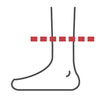Early diagnosis of PAD in primary healthcare is crucial.

70% of patients with PAD experience no symptoms and are not diagnosed. If not discovered and treated on time, PAD can lead to:
 |  |  |  |
| Heart Attack | Stroke | Ulcerations | Amputation |
What is Peripheral Arterial Disease (PAD)?
Peripheral Arterial Disease (PAD) is narrowing of the peripheral arteries, most often due to atherosclerosis. It is caused by build-up of plaque in arterial walls. The blood flow is restricted, but the patient does not feel leg pain or other symptoms.

(Clogged Artery)
Who is at risk for PAD?
-
Individuals over 50 years old with cardiovascular risk factors:





Diabetic
Hypertensive
Smoking
Overweight
High-Cholesterol
-
And, Everyone older than 70.
Signs & Symptoms
-
Individuals over 50 years old with cardiovascular risk factors:
 |  |  |  |  |
Diabetic |
Hypertensive |
Smoking |
Overweight |
High-Cholesterol |
-
And, Everyone older than 70.
Signs & Symptoms
Like many other cardiovascular diseases, PAD is often asymptomatic or presents symptoms, which can be confused with those of other, less or non-serious medical conditions, and is detected only when it is already in a more advanced stage. The most common symptom of PAD is intermittent claudication that often manifests as cramps, numbness and feeling of heaviness (in the legs) during physical exertion.
40% | 50% | Only 10% |
| of individuals with PAD having no symptoms | having symptoms that could be attributed to other medical conditions | having classical PAD symptoms, pain in the legs seems a poor indicator of PAD1 |
Cardiovascular diseases in general are the leading cause of mortality in the world today, accounting for more than 17.9 million deaths in 2016 or 31% of all deaths globally, 85% of which are attributed to heart attack and stroke*. Cancer comes second with an estimated 9.6 million deaths in 20182. Put more succinctly, CVDs kill nearly twice as many people than cancer.
For early diagnosis, consult your doctor for Ankle-Brachial Index screening.
| | World’s Fastest Ankle-Brachial Index Screening Device – Peripheral Artery Disease Diagnosis just in 1-min. For Peripheral Arterial Disease diagnosis, compression and wound healing therapy decision-making. |
